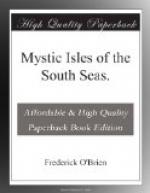“Aue!” cried Haamoura, the chief’s wife.
“Aue!” said the chief, and Rupert Brooke, with whom I had been swimming.
“Aue!” exclaimed O’Laughlin Considine, the Irish poet of New Zealand, stout, bearded, crowned with a chaplet of sweet gardenias, and quoting verses in Maori, Gaelic, and English.
There were laments in Tahitian by all about, sorrow that the mother had so little loved her babe, that she had not brought it to Mataiea, where Tetuanui and Haamoura or any of us would have adopted it. And Lovaina said, in English for Considine, whom she had brought to Mataiea, and for Brooke:
“She had five children by that Tuatini. He is custom-officer at Makatea, phosphate island, near T’ytee. He been gone one year, an’ she get very fat, but she don’ say one thing. Then she get letter speakin’ he come back nex’ week. One ol’ T’ytee woman she work for her to keep all chil’ren clean, an’ eat, an’ she notice two day ago one mornin’ she more thin. She ask her, ‘Where that babee?’ She say the varua, a bad devil, take it. The ol’ woman remember she hear little cry in night, an’ when a girl live my hotel tell her she saw Pepe diggin’ in garden, she talk and talk, an’ by ‘n’ by police come, an’ fin’ babee under rose-bush. It dead, but Cassiou, he say, been breathe when bury, because have air in lung. Then gendarme take hol’ Pepe, and she tell right out she ‘fraid for her husban’, an’ when babee born she go in night an’ dig hole an’ plant her babee under rosebush. Now, maybe white people say that Pepe jus’ like all T’ytee woman.”
Lovaina wore a wine-colored peignoir, and in her red-brown hair many strands of the diaphanous reva-reva, delicate and beautiful, a beloved ornament taken from the young palm-leaf. O’Laughlin Considine and Brooke were much concerned for the unhappy mother, and asked how she was.
“She cut off her hair,” answered Lovaina, “like I do when my l’i’l boy was killed in cyclone nineteen huner’ six. It never grow good after like before.” Her hair was quite two feet long and very luxuriant, and like all Tahitian hair, simply in two plaits.
Brooke expressed his curiosity over what Lovaina had said, “jus’ like all T’ytee woman.”
“Was that a custom of Tahiti mothers, to bury their babes alive at birth?” he asked.
Lovaina blushed.
“Better you ask Tetuanui ’bout them Arioi,” she replied confusedly.
The chief pleaded that he could not explain such a complicated matter in French, and if he did, M. Considine would not understand that language. But with the question raised, the conversation continued about infanticide and depopulation. The chief quoted the death-sentence upon his race pronounced by the Tahitian prophets centuries ago:
“E tupu te fau, et toro te farero, e mou te taata!”
“The hibiscus shall grow, the coral spread, and man shall cease!”
“There were, according to Captain Cook, sixty or seventy thousand Tahitians on this island when the whites came,” continued the chief, sadly. “That number may have been too great, for perhaps Tooti calculated the population of the whole island by the crowd that always followed him, but there were several score thousand. Now I can count the thousands on the fingers of one hand.”




